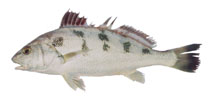Add your observation in Fish WatcherAquaMaps webservice down at the moment
Upload your photos and videos
Pictures | Google imageNibea maculata
Picture by Iranian Fisheries Research Organization (IFRO)
Pictures | Google imageNibea maculata
Picture by Iranian Fisheries Research Organization (IFRO)
Classification / Names Populärnamn | synonymer | Catalog of Fishes(Släkte, Arter) | ITIS | CoL | WoRMS | Cloffa
> Eupercaria/misc (Various families in series Eupercaria) > Sciaenidae (Drums or croakers)
Etymology: Nibea: Greek, niba, nipsis = to wash.
More on authors: Bloch & Schneider.
Etymology: Nibea: Greek, niba, nipsis = to wash.
More on authors: Bloch & Schneider.
Environment: milieu / climate zone / depth range / distribution range Ekologi
marina bottenlevande. Tropical
Utbredning Länder | FAO områden | Ekosystem | Förekomster | Point map | Utplanteringar | Faunafri
Indian Ocean: coasts of India and Sri Lanka, probably extending to Thailand and Malaysia.
Length at first maturity / Size / Vikt / Age
Maturity: Lm 18.0, range 16 - 22 cm
Max length : 30.0 cm TL hane/ej könsbestämd; (Ref. 3490); common length : 22.0 cm TL hane/ej könsbestämd; (Ref. 3490)
Max length : 30.0 cm TL hane/ej könsbestämd; (Ref. 3490); common length : 22.0 cm TL hane/ej könsbestämd; (Ref. 3490)
Found in coastal waters. An important foodfish. Sold fresh and dried salted in markets.
Life cycle and mating behavior Könsmognad | Reproduktion | Lek | Ägg | Fecundity | Larver
Main reference
Upload your references | referenser | Koordinator | Medarbetare
Lal Mohan, R.S., 1984. Sciaenidae. In W. Fischer and G. Bianchi (eds.) FAO species identification sheets for fishery purposes. Western Indian Ocean (Fishing Area 51). Vol. 4. FAO, Rome. pag. var. (Ref. 3490)
IUCN Red List Status (Ref. 130435: Version 2024-2)
Least Concern (LC) ; Date assessed: 25 September 2018
CITES
Not Evaluated
Threat to humans
Harmless
Human uses
Fiskeri: kommersiell
FAO - Publication: search | FishSource |
Ytterligare information
Trophic ecology
Födoslag
Födosammansättning
Födointag
Food rations
Predatorer
Födoslag
Födosammansättning
Födointag
Food rations
Predatorer
Ecology
Ekologi
Ekologi
Population dynamics
Tillväxtparametrar
Max. ages / sizes
Length-weight rel.
Length-length rel.
Length-frequencies
Mass conversion
Rekrytering
Abundans
Tillväxtparametrar
Max. ages / sizes
Length-weight rel.
Length-length rel.
Length-frequencies
Mass conversion
Rekrytering
Abundans
Life cycle
Reproduktion
Könsmognad
Maturity/Gills rel.
Fecundity
Lek
Spawning aggregations
Ägg
Egg development
Larver
Larvdynamik
Reproduktion
Könsmognad
Maturity/Gills rel.
Fecundity
Lek
Spawning aggregations
Ägg
Egg development
Larver
Larvdynamik
Anatomy
Gälyta
Brain
Otolith
Gälyta
Brain
Otolith
Physiology
Body composition
Nutrients
Syreförbrukning
Swimming type
Simhastighet
Visual pigments
Fish sound
Diseases & Parasites
Toxicity (LC50s)
Body composition
Nutrients
Syreförbrukning
Swimming type
Simhastighet
Visual pigments
Fish sound
Diseases & Parasites
Toxicity (LC50s)
Genetics
Genetik
Heterozygosity
Ärftlighet
Genetik
Heterozygosity
Ärftlighet
Human related
Aquaculture systems
Vattenbruksprofiler
Avelslinjer
Ciguatera cases
Stamps, coins, misc.
Aquaculture systems
Vattenbruksprofiler
Avelslinjer
Ciguatera cases
Stamps, coins, misc.
Verktyg
E-book | Fälthandbok | Längdfördelnings-verktyg | Livshistorie-verktyg | Prickkarta | Classification Tree
| Catch-MSY |
Special reports
Download XML
Internet-källor
AFORO (otoliths) | Aquatic Commons | BHL | Cloffa | BOLDSystems | Websites from users | Check FishWatcher | CISTI | Catalog of Fishes: Släkte, Arter | DiscoverLife | ECOTOX | FAO - Publication: search | Faunafri | Fishipedia | Fishtrace | GenBank: genome, nucleotide | GloBI | Google Books | Google Scholar | Google | IGFA World Record | MitoFish | Otolith Atlas of Taiwan Fishes | PubMed | Reef Life Survey | Socotra Atlas | Tree of Life | Wikipedia: Go, sök | World Records Freshwater Fishing | Zoological Record
Estimates based on models
Phylogenetic diversity index (Ref. 82804): PD50 = 0.5010 [Uniqueness, from 0.5 = low to 2.0 = high].
Bayesian length-weight: a=0.00813 (0.00513 - 0.01288), b=3.15 (3.02 - 3.28), in cm total length, based on LWR estimates for this species & (Sub)family-body (Ref. 93245).
Trofisk nivå (Ref. 69278): 3.6 ±0.5 se; based on size and trophs of closest relatives
Generation time: 2.2 ( na - na) years. Estimated as median ln(3)/K based on 2 growth studies.
Resiliens (Ref. 120179): Hög, lägsta populationsfördubblingstid mindre än 15 månader (K=0.49-1.08; Fec=21,584).
Fishing Vulnerability (Ref. 59153): Low vulnerability (17 of 100).




